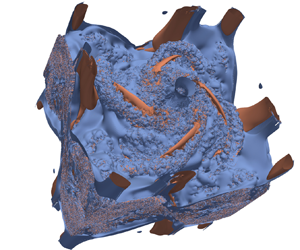Article contents
Numerical evidence of anomalous energy dissipation in incompressible Euler flows: towards grid-converged results for the inviscid Taylor–Green problem
Published online by Cambridge University Press: 15 December 2021
Abstract

The well-known energy dissipation anomaly in the inviscid limit, related to velocity singularities according to Onsager, still needs to be demonstrated by numerical experiments. The present work contributes to this topic through high-resolution numerical simulations of the inviscid three-dimensional Taylor–Green vortex problem using a novel high-order discontinuous Galerkin discretisation approach for the incompressible Euler equations. The main methodological ingredient is the use of a discretisation scheme with inbuilt dissipation mechanisms, as opposed to discretely energy-conserving schemes, which – by construction – rule out the occurrence of anomalous dissipation. We investigate effective spatial resolution up to  $8192^3$ (defined based on the
$8192^3$ (defined based on the  $2{\rm \pi}$-periodic box) and make the interesting phenomenological observation that the kinetic energy evolution does not tend towards exact energy conservation for increasing spatial resolution of the numerical scheme, but that the sequence of discrete solutions seemingly converges to a solution with non-zero kinetic energy dissipation rate. Taking the fine-resolution simulation as a reference, we measure grid-convergence with a relative
$2{\rm \pi}$-periodic box) and make the interesting phenomenological observation that the kinetic energy evolution does not tend towards exact energy conservation for increasing spatial resolution of the numerical scheme, but that the sequence of discrete solutions seemingly converges to a solution with non-zero kinetic energy dissipation rate. Taking the fine-resolution simulation as a reference, we measure grid-convergence with a relative  $L^2$-error of
$L^2$-error of  $0.27\,\%$ for the temporal evolution of the kinetic energy and
$0.27\,\%$ for the temporal evolution of the kinetic energy and  $3.52\,\%$ for the kinetic energy dissipation rate against the dissipative fine-resolution simulation. The present work raises the question of whether such results can be seen as a numerical confirmation of the famous energy dissipation anomaly. Due to the relation between anomalous energy dissipation and the occurrence of singularities for the incompressible Euler equations according to Onsager's conjecture, we elaborate on an indirect approach for the identification of finite-time singularities that relies on energy arguments.
$3.52\,\%$ for the kinetic energy dissipation rate against the dissipative fine-resolution simulation. The present work raises the question of whether such results can be seen as a numerical confirmation of the famous energy dissipation anomaly. Due to the relation between anomalous energy dissipation and the occurrence of singularities for the incompressible Euler equations according to Onsager's conjecture, we elaborate on an indirect approach for the identification of finite-time singularities that relies on energy arguments.
Information
- Type
- JFM Papers
- Information
- Copyright
- © The Author(s), 2021. Published by Cambridge University Press
References
REFERENCES
- 16
- Cited by


